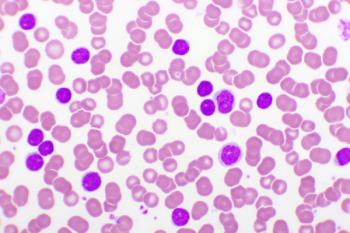
- August 2025
- Volume 31
- Issue Spec. No. 9
- Pages: SP556-SP558
Could On-Body Delivery of Isatuximab Bring More Competition to Anti-CD38 Myeloma Treatment?
Key Takeaways
- The phase 3 IRAKLIA trial showed isatuximab's OBDS matches IV efficacy and pharmacokinetics, with fewer injection-site reactions.
- Subcutaneous isatuximab demonstrated a 71.1% objective response rate, comparable to the 70.5% seen with IV administration.
Results for IRAKLIA show noninferiority for Sanofi's on-body delivery system for isatuximab, compared with IV administration. Patients overwhelmingly preferred the hands-free delivery option.
After falling behind in the early battle for delivering its anti-CD38 monoclonal antibody, isatuximab (Sarclisa), Sanofi appears poised to climb back with a hands-free injector that an investigator calls “potentially transformational.”1
Data from the phase 3 IRAKLIA trial (NCT05405166) showed the on-body delivery system (OBDS) for isatuximab, used to treat patients with multiple myeloma, matched the response rate and pharmacokinetics of the intravenous (IV) version, with only a fraction of the injection-site reactions seen in IV administration.1,2 The results, presented Tuesday at the
Full data from IRAKLIA, which was selected for
Positive trial data for isatuximab, used in various combinations to treat multiple myeloma, have not been sufficient to overcome daratumumab’s outsize advantage with
Xavier Leleu, MD, PhD, head of the Department of Haematology and the Myeloma Clinic at Hôpital La Mileterie, in Poitiers, France, presented the findings at ASCO and later at EHA. In an interview, Leleu noted that although Sanofi brought IV administration time down to 30 minutes with a rapid infusion method,6 the arrival of the on-body device offers an even shorter administration time and an entirely different patient experience. The IRAKLIA results, he said, “represent a potentially transformational advancement in the administration of multiple myeloma treatment.”1
In IRAKLIA, 531 patients with relapsed/refractory multiple myeloma were enrolled and randomized 1:1 to be treated with a combination of fixed-dose subcutaneous (SC) or intravenous (IV) isatuximab with pomalidomide (Pomalyst, Bristol Myers Squibb) and dexamethasone, the regimen from the
After a median follow-up of 12 months, results showed the trial met its primary end points:1-3
- Efficacy. The objective response rate (ORR) for the combination with subcutaneous isatuximab was 71.1% compared with 70.5% for the combination with IV isatuximab, for a risk ratio (RR) of 1.008 (95% CI, .903-1.126; P = .0006).
- Pharmacokinetics. The observed isatuximab mean concentration before dosing (C trough) at steady state (C6D1 pre-dose) with SC isatuximab-Pd was 499 (SD 259) ug/mL compared to 341 (SD 169) ug/mL with IV isatuximab-Pd, establishing noninferiority with a geometric mean ratio (GMR) of 1.532 (90% CI, 1.316-1.784).
The trial also met its secondary end points:1-3
- Efficacy. Very good partial response (VGPR) or better rates were consistent between the 2 formulations: isatuximab SC-Pd was 46.4% and istuximab IV-Pd was 45.9% (RR 1.011; 95% CI: 0.841-1.215; P < .0001). In addition,12-month progression-free survival (PFS) rates were similar: 66.1% for patients treated SC isatuximab-Pd compared with 65.1% of those treated with IV isatuximab-Pd (HR 0.985; 95% CI, 0.726-1.338).
- Pharmacokinetics. The observed isatuximab mean C trough at 4 weeks (C2D1 predose) with SC isatuximab-Pd was 421 (SD 215) ug/mL compared with 302 (SD 117) ug/mL for IV isatuximab-Pd (GMR 1.302; 90% CI 1.158-1.465).
- Reactions. Systemic infusion reactions (IRs) were seen in only 1.5% of patients taking SC isatuximab-Pd, compared with 25% of those treated with the IV formulation (RR, 0.061; 95% CI, 0.022-0.164; P < .0001). Nearly all IRs were grade 1 or 2 and resolved within 1 day. No patients in the SC isatuximab-Pd arm discontinued treatment due to a systemic IR.
- Patient experience. 70% of patients treated with SC isatuximab reported being satisfied or very satisfied with their injection compared to 53.4% in the IV arm (OR 2.036; 95% CI, 1.425-2.908; P = .0001).
- Success rate. 99.9% of the SC isatuximab injections were successfully delivered with no significant safety concerns related to the OBDS.
- Adverse events. No new safety concerns were observed, except for low-grade local injection site reactions (ISRs) associated with SC administration that occurred in less than 1% of injections (19 out of 5145 injections, or 0.4%). Nearly all ISRs were grade 1, with 1 instance of grade 2.
“You can see that there is no difference across [the] arms, which shows that the subcutaneous formulation was very effective in giving appropriate concentration,” Leleu said in an interview.
An On-Body Delivery System
The on-body device, called enFuse, is made by Enable Injections, which designs and manufactures high-volume wearable drug delivery systems. The palm-sized plastic device speeds drug administration with a hands-free system that does not require therapy to be pushed through a syringe—a quality that has earned the device positive reviews in a survey of nurses.8 In addition, the design hides the needle from patients, which helps those with a fear of needles.
“We believe multiple myeloma patients deserve a more convenient and comfortable treatment experience and recognize the crucial role providers play in delivering that care,” Mehul Desai, PharmD, MBA, vice president, Medical Affairs, Enable Injections said in a statement. “Through our collaboration with Sanofi, we’ve aspired to advance an on-body injector that could transform the treatment experience for patients and providers alike.”1
In the interview, Leleu said the trial showed that a flat dose would work across patients of varying weight levels. The 99.9% success rate—meaning the device delivered all the therapy virtually every time1—is very important to clinicians weighing whether to switch patients to a new delivery method, as it indicates that time will not be lost in the clinic due to a device failure.
However, Leleu was especially enthusiastic about the quality of life results in IRAKLIA, as well as those from a second study, IZALCO, which showed patients who switched between the OBDS and the more commonly used syringe preferred the on-body, hands-free design by a 3:1 margin.10 Median injection time was 13 minutes.3
“It’s not only the percentage of patients that said they were happy,” Leleu said. “It’s also the quality of how much they were happy.” Before IRAKLIA, Leleu said, he had not fully appreciated how much some patients fear seeing a needle.
He described patients’ reactions in his own clinic, where those taking part in IRAKLIA were treated alongside patients receiving subcutaneous daratumumab. Leleu said some of the daratumumab patients saw the small disc on others and asked if they could also have the device, which the French patients called “the snail.”
Leleu said he has historically treated equal numbers of patients with daratumumab and isatuximab, but may rethink that, given patients’ and nurses’ reactions to the on-body device. “It's so much time saving, it's so much less labor intensive that that I'm actually questioning myself,” he said.
The leap in innovation comes as use of anti-CD38 therapy is increasing in myeloma. In the past year, both anti-CD38 therapies were approved by FDA as the centerpiece of a quadruplet to treat groups of patients newly diagnosed with multiple myeloma. Based
One unknown at this stage, Leleu said, is whether regulators will approve subcutaneous isatuximab in all current indications where the IV formulation is used. When subcutaneous daratumumab was approved, the
For Leleu, the results of IRAKLIA represent a comeback for isatuximab. “Sanofi was late developing the anti-CD38 antibody, and it was really regrettable,” he said, noting that this allowed daratumumab to capture most of the market. “I’m happy that [Sanofi] compensated. They were late coming, but they learned from the manual push (of the syringe) being difficult. They could have come out with a simple manual push. But to have this new OBDS, this on-body injector device…I think it’s really, really incredible.”
References
- ASCO: new Sarclisa data support subcutaneous administration with on-body injector. Press release. Sanofi. June 3, 2025. Accessed June 4, 2025.
https://www.sanofi.com/en/media-room/press-releases/2025/2025-06-03-12-26-42-3092736 - Leleu XP. Isatuximab (Isa) subcutaneous (SC) via an on-body delivery system (OBDS) vs Isa intravenous (IV) plus pomalidomide and dexamethasone in relapsed/refractory multiple myeloma: results of the randomized, noninferiority phase 3 IRAKLIA study. Presented at: American Society of Clinical Oncology, May 30-June 3, 2025; Chicago, IL: Abstract 7506. doi:10.1200/JCO.2025.43.16_suppl.7506.
- Ailawadhi S, Spicka I, Spence A, et al. Isatuximab subcutaneous by on-body delivery system vs isatuximab intravenous plus pomalidomide and dexamethasone in relapsed/refractory multiple myeloma: phase 3 IRAKLIA study. J Clin Oncol. In press; published online June 3, 2025.
https://doi.org/10.1200/JCO-25-00744 - Soefje SA, Carlson K, Awasthi A, et al. Clinical administration characteristics of subcutaneous and intravenous administration of daratumumab in patients with multiple myeloma at Mayo Clinic infusion centers. JCO Oncol Pract. 2023;19(4):
https://doi.org/10.1200/OP.22.00421 - Ailawadhi S, Špička I, Lu J, et al. Isatuximab subcutaneous via an on-body delivery system versus isatuximab intravenous, plus pomalidomide and dexamethasone, in relapsed/refractory multiple myeloma: the randomized phase 3 IRAKLIA study. Presented at: 2025 European Hematology Association Congress; June 12-15, 2025; Milan, Italy. Abstract S203.
- Kotb R, Geirnaert M, Rimmer E, et al. Real-world safety and tolerability of rapid, 30-minutes, intravenous isatuximab in patients with multiple myeloma. Clin Lymph Myeloma Leuk. Published online January 27, 2025.
https://doi.org/10.1016/j.clml.2025.01.022 . - Attal M, Richardson PG, Rajkumar SV, et al. for the ICARIA-MM Study Group. Isatuximab plus pomalidomide and low-dose dexamethasone versus pomalidomide and low-dose dexamethasone in patients with relapsed and refractory multiple myeloma (ICARIA-MM): a randomised, multicentre, open-label, phase 3 study. Lancet. 2019;394(10214):2096-2107. doi: 10.1016/S0140-6736(19)32556-5
- Desai M, Faiman B, Gorski LA, Miles A, Sterlin V, Curry N. Evaluating nurse preferences for a novel on-body delivery system vs. manual syringes for large-volume subcutaneous drug administration: a survey study.Drug Deliv. 2025;3;32(1):2484278. doi:
10.1080/10717544.2025.2484278 - Caffrey M. On-body delivery system enFuse saves time, improves QOL for patients. Am J Manag Care. 2024;30(Spec 4): SP352
- Parmar G, Capra M, Seguro F, et al. Efficacy and safety of isatuximab subcutaneous (SC) plus carfilzomib and dexamethasone (Isa-Kd) in patients with relapsed/refractory multiple myeloma (RRMM): Results of the phase 2 study IZALCO. J Clin Oncol. 2025;43(suppl 16): Abstract 7526 P
- Facon T, Dimopoulos MA, Leleu XP, et al. Isatuximab, bortezomib, lenalidomide, and dexamethasone for multiple myeloma. N Engl J Med. 2024;391(17):1597-1609. doi:10.1056/NEJMoa2400712
- Sonneveld P, Dimopoulos MA, Boccadoro M, et al for the PERSEUS Trial. Daratumumab, bortezomib, lenalidomide, and dexamethasone for multiple myeloma. N Engl J Med. 2024;390(4):301-313. DOI: 10.1056/NEJMoa2312054
- Facon T, Zweegman S, Hungria V, et al. Daratumumab plus bortezomib, lenalidomide, and dexamethasone (D-VRd) in patients with newly diagnosed multiple myeloma (NDMM): Subgroup analysis of transplant-ineligible (TIE) patients in the phase 3 CEPHEUS study. J Clin Oncol. 2025;43(suppl 16): Abstract 7516. DOI: 10.1200/JCO.2025.43.16_suppl.7516.
- Facon T, Kumar S, Plesner T, et al. Daratumumab plus lenalidomide and dexamethasone for untreated myeloma. N Engl J Med 2019;380(22):2104-2115.DOI: 10.1056/NEJMoa1817249
Articles in this issue
Newsletter
Stay ahead of policy, cost, and value—subscribe to AJMC for expert insights at the intersection of clinical care and health economics.









































